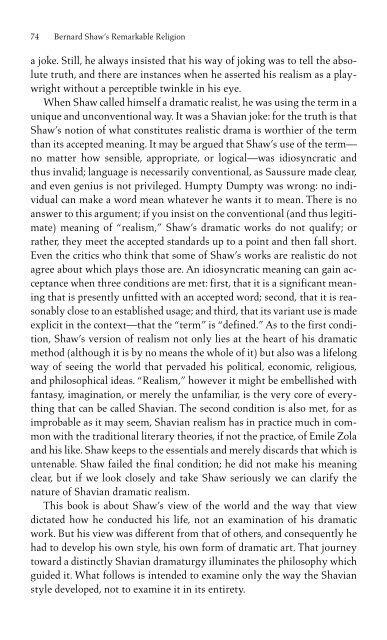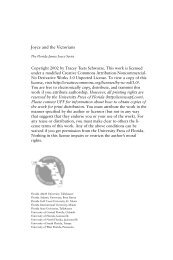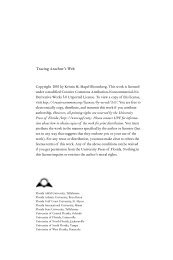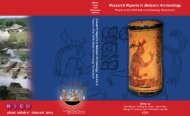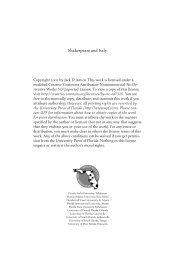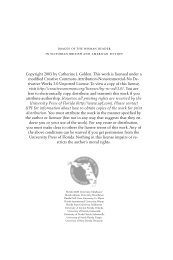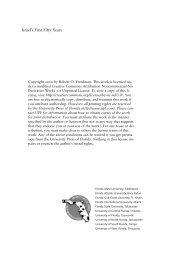Bernard Shaw's Remarkable Religion: A Faith That Fits the Facts
Bernard Shaw's Remarkable Religion: A Faith That Fits the Facts
Bernard Shaw's Remarkable Religion: A Faith That Fits the Facts
Create successful ePaper yourself
Turn your PDF publications into a flip-book with our unique Google optimized e-Paper software.
74 <strong>Bernard</strong> Shaw’s <strong>Remarkable</strong> <strong>Religion</strong><br />
a joke. Still, he always insisted that his way of joking was to tell <strong>the</strong> absolute<br />
truth, and <strong>the</strong>re are instances when he asserted his realism as a playwright<br />
without a perceptible twinkle in his eye.<br />
When Shaw called himself a dramatic realist, he was using <strong>the</strong> term in a<br />
unique and unconventional way. It was a Shavian joke: for <strong>the</strong> truth is that<br />
Shaw’s notion of what constitutes realistic drama is worthier of <strong>the</strong> term<br />
than its accepted meaning. It may be argued that Shaw’s use of <strong>the</strong> term—<br />
no matter how sensible, appropriate, or logical—was idiosyncratic and<br />
thus invalid; language is necessarily conventional, as Saussure made clear,<br />
and even genius is not privileged. Humpty Dumpty was wrong: no individual<br />
can make a word mean whatever he wants it to mean. There is no<br />
answer to this argument; if you insist on <strong>the</strong> conventional (and thus legitimate)<br />
meaning of “realism,” Shaw’s dramatic works do not qualify; or<br />
ra<strong>the</strong>r, <strong>the</strong>y meet <strong>the</strong> accepted standards up to a point and <strong>the</strong>n fall short.<br />
Even <strong>the</strong> critics who think that some of Shaw’s works are realistic do not<br />
agree about which plays those are. An idiosyncratic meaning can gain acceptance<br />
when three conditions are met: first, that it is a significant meaning<br />
that is presently unfitted with an accepted word; second, that it is reasonably<br />
close to an established usage; and third, that its variant use is made<br />
explicit in <strong>the</strong> context—that <strong>the</strong> “term” is “defined.” As to <strong>the</strong> first condition,<br />
Shaw’s version of realism not only lies at <strong>the</strong> heart of his dramatic<br />
method (although it is by no means <strong>the</strong> whole of it) but also was a lifelong<br />
way of seeing <strong>the</strong> world that pervaded his political, economic, religious,<br />
and philosophical ideas. “Realism,” however it might be embellished with<br />
fantasy, imagination, or merely <strong>the</strong> unfamiliar, is <strong>the</strong> very core of everything<br />
that can be called Shavian. The second condition is also met, for as<br />
improbable as it may seem, Shavian realism has in practice much in common<br />
with <strong>the</strong> traditional literary <strong>the</strong>ories, if not <strong>the</strong> practice, of Emile Zola<br />
and his like. Shaw keeps to <strong>the</strong> essentials and merely discards that which is<br />
untenable. Shaw failed <strong>the</strong> final condition; he did not make his meaning<br />
clear, but if we look closely and take Shaw seriously we can clarify <strong>the</strong><br />
nature of Shavian dramatic realism.<br />
This book is about Shaw’s view of <strong>the</strong> world and <strong>the</strong> way that view<br />
dictated how he conducted his life, not an examination of his dramatic<br />
work. But his view was different from that of o<strong>the</strong>rs, and consequently he<br />
had to develop his own style, his own form of dramatic art. <strong>That</strong> journey<br />
toward a distinctly Shavian dramaturgy illuminates <strong>the</strong> philosophy which<br />
guided it. What follows is intended to examine only <strong>the</strong> way <strong>the</strong> Shavian<br />
style developed, not to examine it in its entirety.


